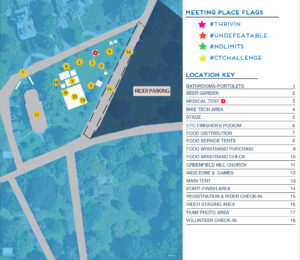Bike Safety During our Bike Ride for Cancer
Weather Conditions
Weather is unpredictable and rain is a very real possibility. Barring severe weather emergencies, the CT Challenge Ride continues despite poor weather conditions. Riders should be prepared for high winds, temperatures ranging from 50-100 degrees Fahrenheit, heavy rainfall, and/or a combination of these conditions.
Given that weather can change during the event, weather-related announcements may need to be issued after the start of the Ride.
- Green Flag — Safe to Proceed
Fair weather through light/moderate rain - Yellow Flag — Proceed with Caution
Excessive heat, moderate to strong winds, heavy rain or other precipitation is creating potentially hazardous situations on the route. - Red Flag — Do Not Proceed
Severe weather warnings have been issued by the National Weather Service or severe precipitation is creating hazardous is considered unsafe at this time. Riders who proceed do so at their own risk.
CT Challenge Ride organizers reserve the right to postpone the Ride start, reduce the Ride length, restrict Ride options, or cancel the Ride to ensure the safety of its participants. We will do everything within our capabilities to communicate cancellation, postponement, or alteration of the event to Riders as quickly as possible. In all cases, Riders are responsible for their own safety and should use their best judgment in deciding whether or not to continue if severe weather conditions exist.
ALL CT CHALLENGE ROUTES CLOSE AT 5:00 PM ON SATURDAY. ANY RIDERS STILL ON THE COURSE AT THIS TIME WILL BE REQUIRED TO ACCEPT A RIDE BACK TO THE GREENFIELD HILL IN A CT CHALLENGE SUPPORT VEHICLE.
Rules and Regulations
Cyclists have the same rights and obligations as motor vehicles when traveling the roadways and must follow the same rules and regulations. Cyclists are subject to fines for disobeying the law. Traffic summonses may be issued to cyclists for running stop signs and red lights or riding on the wrong side of the road. It is important that every cyclist abide by the rules and regulations of safe bicycle riding. Take the time to review the following information and understand its importance before you begin to ride.
- Helmets: All cyclists are required to wear ANSI, SNELL or CPSC approved helmets during the ride.
- No selfies or selfie sticks when you’re in the saddle: Save your selfies for the opening ceremony, rest stops and the finish line.
- Rules of the Road: All cyclists are obligated by law to obey all traffic signals. Cyclists must abide by the same rules and regulations as motorists.
- At intersections: Cyclists must stop at all marked intersections. At all intersections, with or without stop signs, cyclists should yell “car left” or “car right” to other cyclists if cars are approaching from either of those directions.
- Ride single file, especially in high traffic areas.
- Stay right: During cycling tours, stay to the right and stay in a single line.
- Before making a left turn, first check traffic to see if any cars are coming and fully extend your left arm and point in that direction. Signal well in advance of the actual turn and then position your bike so that traffic can move around you.
- When making a right turn, fully extend your right arm and point in the intended direction. Some cyclists signal a right turn by holding their left arm out with the forearm pointing up. Either way is correct. You should signal well in advance of the actual turn, and then use both hands to steer through the turn.
- Call out debris, hazards: If there is debris or a hazard in the road, fully extend your arm and point to the hazard to alert cyclists behind you. Sometimes moving your arm while pointing draws more attention to the debris. Potholes, branches, sand, glass, storm drains, etc. should be called out as a courtesy to riders in the rear.
- When slowing or stopping, fully extend your arm down and out with the palm of your hand facing those who might be behind you. Call out “slowing” or “stopping” while displaying your hand signal to forewarn riders behind you that you are slowing or stopping.
- When passing, call up to the rider you are passing and announce, ”on your left.” Check that you are not cutting off another rider and only pass on the left, leaving about three feet of clearance. If you are being passed, continue straight; do not turn and look back.
- When a car is approaching from behind, call out to the riders up ahead of you, “car back.” This warning should be passed along by each rider to the front of the group until there is no one left to warn. On hearing this warning, move to the right and ride single file.
- When a car is approaching from ahead, call out to the riders behind you, “car up.” This warning should be passed along by each rider to the back of the group until there is no one left to warn. On hearing this warning, move to the right and ride single file.


